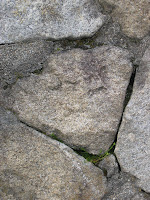
The books have arrived!!! I'm now trying a variety of stitches in the same color.
In this picture, the first column (top to bottom) are tie stitch, rice stitch, florentine stitch, long armed cross stitch (is there a one-armed bandit stitch?), second column: smyrna stitch, and Italian cross stitch. I can see that the different stitches produce different effects... to my (untrained) eye, the tie stitch looks like a careful, fixed, background, maybe if there's a rather orderly surface of something, this might look okay. The rice stitch seems to give a feeling of a rough texture, the florentine stitch (on a normal canvas?) would be good for a smooth surface or background, the long armed cross stitch has a slightly rougher appearance, but has a certain flow to it. The smyrna stitch looks like a plant (or fireworks) or at least gives a light feeling, and the Italian stitch seems to me to be somewhere in between the rice stitch and the smyrna - the rice stitch seems thick, the smyrna thin. (Not sure any of this is right. Just my initial impressions.)
I can see how the variety of these stitches add texture - knobbly or smooth, bristly or flat - to a representation of a wall. However, some "threads" don't lend themselves to being used as such. Note to self: stay away from the fluffy, mischievous kind of yarn.

.jpg)





